The Relationship Between Owner and Dog Anxiety

April 4, 2024
One of the more intriguing impressions is the apparent correlation between anxious owners and dogs exhibiting anxious behavior, aggressive behavior, or both.
Therapy Dog Class
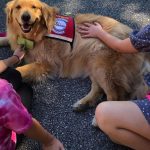
November 28, 2022
Alan Towles and his Golden Retriever, Gracie, recently graduated from CPT’s Therapy Dog Class taught by Melissa Nelson. They are now a working therapy team for Happy Tails. CPT’s Therapy Dog Class provides a unique curriculum that rapidly prepares human and canine students to excel in practical therapy environments. The class teaches multiple task behaviors that […]
Agility Titlist!

November 18, 2022
CPT agility student Meghan Toler and her Miniature Schnauzer/Yorkshire Terrier mix, Lincoln, recently achieved 2 qualifying scores with 2 first place finishes in AKC competition. Congratulations Meghan!! Regardless of whether you wish to participate solely for fun or have competition aspirations, CPT has an outstanding agility program. Our group class and private lesson programs build human-dog […]
Tricks Class Graduates and AKC Tricks Titlists!

Trick or treat? What about tricks for treats? You can get that with CPT’s Tricks Class! Congratulations to Sarah Boone and Millie, Marian Scopa and Zealand, and Chris Griswold and LouLou, our recent CPT Tricks graduates! In the process, each handler-dog team earned the title of AKC Tricks Dog. Outstanding! Tricks improves human-dog team building. […]
CPT Visits Montana

September 21, 2022
CPT has periodically explored purchasing a large tract of land in Montana to construct and operate a service dog facility that would educate animals for domestic clients residing throughout the USA and Canada. Since the Western USA in the Mountain time zone contains more economical land purchase opportunities than in the Eastern time zone or […]
Nat Geo Author Interviews CPT’s Alex Collier and Mark Spivak

November 3, 2021
National Geographic author Jenny Holland recently visited CPT to interview CPT’s Alex Collier and Mark Spivak for an upcoming book Jenny is writing about canine cognition. Day 1: Jenny Holland’s visit commenced on Monday, August 16, 2021. The day began by Alex discussing olfactory and cognitive processing pertinent to search and rescue and cadaver […]
CPT’s Mark Spivak Listed as Expert by Redfin

April 27, 2021
Redfin, the Seattle-based, discount real estate brokerage, listed CPT’s Mark Spivak as an expert in a recent article entitled, “Moving with Pets: Expert Tips for a Successful Move.” Relocating residences can be a harrowing experience for pets, especially those who are neophobes, where they strongly prefer familiarity and routine. Moreover, moving is stressful for humans. […]
CPT Featured on PBS’s Your Fantastic Mind

October 2, 2020
CPT was recently featured in the PBS documentary series “Your Fantastic Mind.” The episode, “Dogs,” premiered on Wednesday, September 14, 2020 and is currently available via online streaming. Georgia Public Broadcasting (GPB) produced, directed, and edited “Dogs,” which was filmed at CPT and at Emory University. The episode discusses scientific discoveries related to dog cognition […]
CPT Featured in CNN.com Article on Virtual Dog Training

April 27, 2020
CNN.com author Ryan Bergeron featured CPT in an April 26, 2020 article about virtual dog training. The article, entitled “Tips for Training Your Dog While You’re Stuck at Home,” discusses the benefits of virtual dog training versus allowing problems to fester, how to socialize a puppy or newly adopted adult dog while maintaining social distancing, […]
CPT Service Dog Program Featured in NY Times Bestseller

April 16, 2020
The CPT Service Dog Program earned significant coverage in the recent New York Times bestselling book “Doctor Dogs,” authored by Maria Goodavage. Doctor Dogs communicates heartwarming stories of how highly trained dogs provide medical benefit to humans.
CPT Service Dog Program Featured Nationally in People Magazine

March 27, 2020
We are proud to announce that the CPT Service Dog Program has been acknowledged nationally in the January 13, 2020 issue of People Magazine and the January 16, 2020 publication of People.com.
Safe Dog Training Options During COVID-19

March 25, 2020
Group dog training classes typically provide a fun and inexpensive option for improving a pet’s obedience performance. However, during times of social distancing the human proximity of group class may pose an unacceptable infection risk. Furthermore, municipal, county, or state government edict may restrict CPT’s ability to legally conduct group class. Therefore, with the onset […]
CPT’s Mark Spivak Presents at 2019 International Canine Science Conference

October 27, 2019
CPT and Dog Star Technologies founder and CEO Mark Spivak was an invited speaker during the 2019 International Canine Science Conference held from October 18 – 20 in Phoenix, Arizona. The 3-day Canine Science Conference featured nationally and internationally renowned speakers in the fields of canine genetics, canine anthropology, canine neuroscience, canine behavior, canine training, […]
CPT’s Mark Spivak Performs as Keynote Speaker at the 2019 AKC US Detection Dog Conference
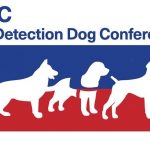
September 1, 2019
The 3rd annual AKC US Detection Dog Conference brought together scientific researchers, veterinarians, military program managers, government officials, law enforcement officers, trainers, breeders, and other stakeholders pertinent to the national security goal of improving the procurement, identification, and training of optimal explosive and agriculture detection dogs. From Aug 27 – 29, 2019, 200 attendees learned, shared, […]
CPT Cat Training Featured in Simply Buckhead Magazine

August 1, 2019
CPT’s cat training and behavior modification program was recently featured in the July/August edition of Simply Buckhead magazine. CPT’s cat training most frequently addresses littler box; anxiety; general socialization; environmental conditioning; new pet integration; and cat-human, cat-dog, and cat-cat aggression issues. However, sometimes clients request obedience behaviors, such as coming when called, which can be […]
CPT’s Mark Spivak Named a Top 100 Author

May 13, 2019
CPT’s Mark Spivak, along with his colleagues from the Emory Canine Cognitive Neuroscience Laboratory, Ashley Prichard, Raveena Chhibber, Kate Athanassiades, and Greg Berns, were name Top 100 Authors by the academic journal Scientific Reports. Their paper, Fast Neural Learning in Dogs: A Multimodal Sensory fMRI Study, was one of the Top 100 read neuroscience papers in […]
The Multifarious Benefits of Dog Agility- Nikos: A Case Example

April 12, 2019
Nikos’s Obedience and Agility History with CPT: Nikos, a 4.25-year old English Cream Retriever, first came to CPT in July 2015 to resolve leash walking and recall problems. CPT’s in-home private lesson and board train programs promptly achieved lesson plan obedience goals both on and off-leash. However, his owner still sought a way to improve […]
Caroline Joe and Dash During Advanced Agility Class

April 6, 2019
Caroline Joe and Dash completed Beginner Obedience, Intermediate Obedience, Beginner Agility, Intermediate Agility, and Intermediate Agility-2 classes with CPT. Now, they are in their second 8-week session of Advanced Agility class. Agility class has helped to improve the bond between Caroline and Dash. Just as importantly, agility has done wonders to improve Dash’s off-leash attentiveness, […]
Would You Help Us To Better Understand Dog Behavior?

April 4, 2019
Comprehensive Pet Therapy (CPT) is supporting Dog Star Technologies in an exciting and potentially groundbreaking research project. The project aims to develop a genetic test to predict key behavior traits of service dog candidates and shelter animals. During 2018, Dog Star Technologies, LLC completed a government-funded genetic research study that produced promising results in a population […]
CPT’s Mark Spivak Completes Legal Course on Police K9 Searches

April 1, 2019
On January, 18, 2019, CPT’s Mark Spivak, a noted expert witness on canine behavior completed a course entitled, “K9 Handler Intensive Training,” held at the Georgia Public Safety Training Center in Forsyth, GA. The course, sponsored by Animal Law Source and the Prosecuting Attorneys Council of Georgia, focused on specialized legal issues related to the […]
Service Dog News

March 31, 2019
Research in France Finds that Dogs Can Smell Seizures- Plus Tax Strategies for Service Dog Owners Can Dogs Smell a Seizure? Yes They Can: In a journal article published in Scientific Reports entitled, “Dogs Demonstrate the Existence of an Epileptic Seizure Odour in Humans,” researchers from the University Rennes in Normandy, France produced a potentially […]
CPT Trainer Seminar- Canine Olfaction

January 2, 2019
On Saturday, December 15, CPT Trainer Alexandra “Alex” Collier delivered an outstanding seminar on canine olfaction to CPT Atlanta’s trainers. Alex is a member of Central Georgia K-9 Search and Rescue. Alex and her Boxers, Angie and Darwin, are certified by the National Association for Search and Rescue (NASAR), North American Police Working Dog Association (NAPWDA), and Georgia Emergency Management Administration (GEMA). Her dogs are certified both in human search and rescue/trailing and cadaver search/human remains detection.
CPT Visits Los Angeles

December 28, 2018
Although CPT already services dog training clients from throughout the country in our Board Train Service Dog Program, our pet board train program, via FaceTime consultations, and via one-time fly-in consultations, over the past few years CPT has explored physical business expansion within various national and international locales. During January through October 2018 we investigated Philadelphia, PA; Eugene, OR; Portland, OR; Mount Hood, OR; Montreal, Canada; Toronto, Canada; Panama City, Panama; Coronado, Panama; and El Valle de Anton, Panama and in June opened our first satellite location in Eugene, Oregon. In November 2018 we continued our examination of prospective future satellite locations by taking a trip to Los Angeles, CA and the surrounding LA County area.
Mark Spivak Featured Panelist at Major Scientific Conference

December 7, 2018
CPT founder and Dog Star Technologies co-founder Mark Spivak was a featured panelist at the 5thAnnual International Animal-Computer Interaction Conference, entitled “ACI 2018.” The Conference, held on the campus of Georgia Tech University, included speakers and participants from the USA, Australia, England, Finland, France, Germany, Israel, Italy, Japan, Russia, Spain, and Sweden. Workshops and presentations […]
The Top 5 Dog Trainers in Atlanta

December 4, 2018
Nobody else in Atlanta matches Mark’s background of competition training, pet dog training, behavior modification experience, education, and canine neuroscience research.
10 Reasons to Train Your Dog with CPT

December 2, 2018
1) CPT has been in business since 1992.
Unlike many fly by night operations in the pet industry, we have stood the test of time.
2) CPT has trained over 50,000 dogs and over 100 cats.
Not only have we been around, we have been successful. We have experience in both years and numbers.
Mark Spivak Speaks At The State Bar Of GA

October 6, 2018
CPT founder and Head Trainer, Dog Star Technologies co-founder and Chief Operating Officer, and noted expert witness in the field of canine behavior Mark Spivak presented at the 20thannual “Animal Law, Enforcement, Veterinary, and Shelter Symposium” hosted by Animal Law Source. The Symposium was held at the Georgia Bar Association building in Atlanta on October 3 and […]
CPT’s Mark Spivak Co-Authors Paper Published in Frontiers in Veterinary Science

September 11, 2018
The paper presented 4 case examples of canine patients, where without anesthesia and without exposure to ionizing radiation in less than 5 minutes awake MRI effectively diagnosed: 1) nasal carcinoma, 2) brain tumor, 3) abdominal lipoma, and 4) idiopathic epilepsy.
CPT’s Mark Spivak Co-Authors Article in Animal Sentience
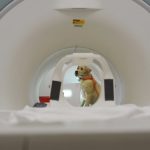
August 1, 2018
The study used noninvasive fMRI brain imaging to measure activity in the amygdala of dogs upon exposure to a human-dog social situation where the dog’s caregiver provided attention to another dog. No previous study neuroscientifically showed the exhibition of canine jealousy.
Jealousy progresses beyond envy. Whereas envy is a desire to obtain resources in the possession of another, jealousy is identified by a set of negative emotional and behavioral responses when a rival receives something one wants for oneself. Although several brain regions, including the hypothalamus and insula, may activate upon the onset of jealousy, the amygdala is the most relevant brain region.
CPT Opens Eugene, Oregon Satellite Location

May 15, 2018
CPT recently opened the first of what we hope are multiple satellite locations. The location we selected is Eugene, Oregon. We selected Eugene for multiple reasons. First, an outstanding trainer who formerly worked for CPT in Atlanta moved with her husband to Eugene and later expressed interest in renewing a business relationship. Thus, the trainer […]
CPT’s Mark Spivak Attends The 2018 PennVet Working Dog Conference

April 30, 2018
CPT founder and Head Trainer and Dog Star Technologies Chief Operating Officer Mark Spivak attended the 2018 PennVet Working Dog Conference proximal to the campus of the University of Pennsylvania’s School of Veterinary Medicine. The 4-day conference featured nationally and internationally recognized speakers in the multidisciplinary fields of canine genetics, breeding, scent dog training, service dog training, evaluation, nutrition, fitness, behavior, and veterinary health.
CPT Expert Witness Services Prove Vital in Two Recent Cases

April 2, 2018
CPT’s Mark Spivak is an experienced and talented expert witness in criminal and civil legal cases that involve animal behavior, animal training, animal handling, or animal husbandry practices. Mark represents either the plaintiff or defense. His one rule before accepting an assignment is that he must have passion for the case and for the attainment […]
CPT’s Mark Spivak Attends the 2017 Canine Science Conference

October 9, 2017
From October 6 – 8, CPT founder and Head Trainer and Dog Star Technologies Chief Operating Officer Mark Spivak attended the 2017 Canine Science Conference on the campus of Arizona State University in Tempe, Arizona. The 3-day Canine Science Conference featured nationally and internationally renowned speakers in the field of canine genetics, canine behavior, and […]
Early Socialization

December 26, 2016
Be sure to socialize your puppy early and often. Early socialization to people, puppies, dogs, cats, multiple floor and ground substrates, novel objects, noises, and various environments will maximize the probability that your future adult dog will become a happy and welcome member of the community.
Considerations When Hiring an Expert Witness in Dog Behavior

December 8, 2016
A Case Example of a Man in Need of an Expert Witness: Bennett Anderson walked into the Cobb County jailhouse. However, he did not enter under his own accord. Law enforcement officers surrounded his body and controlled his every movement. His hands were cuffed behind his back. The tightness of the metal braces constricting his […]
The Importance of Dog and Litter Evaluations

August 30, 2016
Evaluations for Service Dog Programs When CPT designs a client’s service dog program the first step is a Phase I- Introductory Meeting. During the Meeting, we: a) obtain medical details regarding the recipient’s disability, b) discuss the limitations and effects posed by the disability, c) outline the overall goals and objectives of the program, d) […]
Canine Play Styles

June 26, 2016
CPT Trainers often get asked, “Is my dog playing or fighting?” Similarly, our Head Trainers conduct behavioral analyses of dogs removed from dog day care because the day care operator and dog owner are uncertain regarding the intent of a dog’s behavior or because the operator says that a dog plays “too rough.”
Therefore, the natural segue leads to several questions:
How can I tell if my dog is playing or fighting?
How rough is too rough?
What criteria should I evaluate when selecting playmates for my dog?
When and how should I intervene when my dog plays with another dog?
Recent Research Raises Concerns Regarding Early Spaying/Neutering

November 2, 2015
Whereas in the early part of the 20th century pet ownership was common only to rural American households, after World War 2 the country experienced the baby boom, an increased urbanization and suburbanization of society, and an expansion of pet ownership within non-rural households. Subsequently, with the advent of a significant increase in pet ownership in high-density population areas, concomitant problems developed. The number of stray and unwanted pets increased in regions where the issue received more political attention and posed greater public health and safety concerns than when stray pets remained principally a rural issue. Moreover, without strategic fertility control measures, given the frequency of stray dog and cat copulations and the size of resultant litters, the pet population grew prolifically.
CPT and Emory Want You- And Your Dog- To Tryout for Our fMRI Research Team

CPT and the Emory Canine Cognitive Neuroscience Laboratory are enrolling a new team of dogs for our safe, noninvasive, fun, and exciting fMRI and behavioral research projects. The projects, which are funded by the Office of Naval Research (ONR) examine canine cognition, emotions, sensory perception, receptive communication, and inhibitory control. In addition, the team plans upcoming studies on reward systems and jealousy relevant to improving the training protocols for pet owners and studies on olfaction relevant to the performance of police narcotics detection dogs and military explosive detection dogs.
Canine Influenza Questions and Answers- Updated- July 24

July 24, 2015
Recently, the media, certain veterinarians, and some clients have expressed concern about the spread of Canine Influenza. According to multiple sources (CBS46.com, WXIA-TV, Inquisitr.com), since May 15, 2015, the date of the first confirmed Georgia case, there has been only the lone occurrence of H3N2 canine influenza in the state of Georgia. Media research has not shown any additional confirmed cases of canine flu in Georgia as of the date of this article (June 1, 2015).
Preventing Cold Weather Calamities

November 8, 2014
Does your dog like cold weather? To many dogs, Georgia winter conditions are far more hospitable than are the supposed “dog days” of summer. Nevertheless, many dogs are poorly suited for the drop in outdoor temperatures that accompany the winter season. Such dogs may experience hypothermia, frostbite, cracked pads, and stress when left outdoors for an extended period.
Evaluate a Dog for Suitability Before Bringing it Home

August 17, 2014
As discussed within the Dog Training Articles section in the composition “Selecting the Right Dog,” the decision regarding adding a dog to your household is in many ways tantamount in significance and perspective to your decision when selecting a mate. You hope that each will successfully reside in your home for an extended period of time. Therefore, compatibility is essential.
Know the Signs of Heat Exhaustion and Heat Stroke (Full Version)

July 12, 2014
The summer is a great time for you and your family to play and exercise outdoors with your dog. However, dogs do not thermoregulate as well as humans. Therefore, to reduce the possibility of heat exhaustion or potentially life threatening heat stroke, you will need to monitor your dog when playing or exercising outdoors on hot days.
Know The Signs of Heat Exhaustion and Heat Stroke (Abstract)

Symptoms of canine heat stroke include: 1. Excessive and/or seemingly uncontrollable panting, 2. Inordinately viscous saliva, 3. Stupor, 4. Ataxia- loss of coordination, 5. Bright red tongue or gums, 6. Uncommonly pale gums, 7. Loss of skin elasticity, 8. Dry mucous membranes, 9. Diarrhea or bloody diarrhea, 10. Tachycardia, 11. Weak pulse- from hypotension, 12. […]
Behavior Modification Q & A

November 15, 2013
Typically, we can construct counterconditioning and systematic desensitization drills that remain beneath the dog’s stress threshold. We design the drills with two primary goals. Our first goal is building the subject dog’s relaxation, confidence, security, and trust amidst the stimulus. Our second goal is teaching the dog a passive replacement behavior that the dog will perform in lieu of the previous reactive behavior (barking, lunging, snarling, biting, et al.). We wish to modify the emotional state of the animal from an aroused emotional state to a calm, composed emotional state. Consequently, during the behavior modification process, the subject dog will gradually accept increasing levels of exposure to the stimulus without becoming reactive.
Breed Specific Legislation

In summary, although the number of annual domestic fatalities due to dog bites is relatively small, according to various news organizations an average of approximately 20 per year and a high of 34 in any one year for fatalities combining where the breed is known and unknown, the number of total non-fatal dog bites and the total of non-fatal injurious dog bites is high and the resultant financial loss, pain, and human suffering is significant. Moreover, at least in the case of fatal dog bites, specific breeds (Pit Bull and Rottweiler) are notably and consistently represented.
Estate Planning Considerations For Our Pets (Abstract)
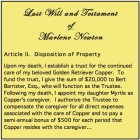
For those desiring more detailed information about estate planning considerations for pets, including the use of wills, gifting, inter vivos pet trusts, testamentary pet trusts, durable medical powers of attorney, financial powers of attorney, and emergency plans, please read the full-length version of the CPT article “Estate Planning Considerations for Pets.”
Estate Planning Considerations For Our Pets (Full Version)

In the past, most Americans kept their pets as solely or primarily outdoor companions that were only peripherally part of the family. However, nowadays pets frequently enjoy full indoor privileges, including sleeping on the bed, and are often more pampered than the family’s children. Nevertheless, even though Americans have evolved regarding the emotional attachment and comforts they provide their pets, the American legislative and legal system, with the exception of criminal cruelty laws, still generally regards pets as chattel. Thus, the privileges and stipulations provided pets in the law are often limited in consideration, tantamount to the privileges and stipulations provided non-real property, such as furniture, bank accounts, old photographs, or other inanimate possessions. Yet, with proper planning, in the area of probate law, our pets can receive the treatment they deserve as sentient beings, rather than remain treated in a manner equivalent to our furniture.
The average lifespan for a domestic dog generally ranges between 10 – 16 years, depending on the breed, and the average lifespan for a domestic cat maintained indoors ranges between 12 to 17 years. In contrast, the average human lifespan in the United States is 73.6 years for males, 79.4 years for females, and approximately 77 years overall. Moreover, since the preceding statistics take into account infant mortality and early death, the average life expectancy for a person who already has reached adulthood is much higher. For instance, actuarial tables show that a 40-year old is likely to live to the age of 79 and a 66-year old is likely to live to the age of 84. Therefore, the vast majority of CPT clients will outlive their pets.
Nevertheless, not everyone will experience a long, healthy lifespan. Unfortunately, regardless of their stage of life, some CPT clients will suffer accidents, unexpected illness, or debilitating physical conditions that will cause premature death or disable their physical or mental capacity to properly care for their beloved pet(s). Consequently, expressing true love and care for our pets should extend beyond regular feeding, playtime, health maintenance, or even CPT training. We also should author an estate plan that strategizes and pre-arranges the care of our animals should unfortunate contingencies occur that cause death, permanent or temporary disability, or emergencies that suddenly take us away from home for extended periods, whereby we are unable to properly care for our pets.
Loose-Leash Walking (Abstract)
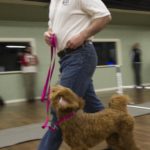
To most effectively and most humanely address any dog training or behavioral problem, we wish first to diagnose the origin of the behavior. Pulling on leash is most commonly caused by:
1) General excitability,
2) General under-stimulation,
3) Excitability or arousal directed toward or emanating from a specific stimulus,
4) Dominance,
5) Lack of knowledge regarding walking protocol, or
6) A thigmotactic (opposition) reflex.
Loose-Leash Walking (Full Version)

If all goes according to plan, your dog will calmly and cooperatively walk on a loose leash. Subsequently, both you and your dog will receive more pleasure and bonding from your neighborhood walks. Moreover, when you begin to receive more enjoyment from your walks, you will probably walk your dog more, which increases your dog’s quality of life.


